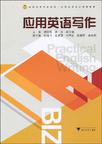应用英语写作
出版时间:2009-9 出版社:浙江大学出版社 作者:胡丽纯,蒋萍,夏宁满 主编 页数:181
内容概要
《应用英语写作》内容简介:21世纪我国高等教育尤其是高职教育发展迅速。近年来我国高校持续扩大招生,学生的英语基础参差不齐,如何选择实用高效的英语教材,让学生在有限的学制和时间内更有效地掌握英语基础知识和技能,就成为英语界同仁们共同关心和研究的课题。为此,本编写组经过几年的实践和积累,在潜心调研高职学生毕业后所从事的外向型核心岗位对英语写作的现实需求的基础上,根据全国《高等学校英语高职专业英语教学大纲》的内容和精神,编写了《应用英语写作》这本教材。本教材旨在系统训练学生的英语写作能力,帮助学生掌握并熟练运用英语写作基础知识和技巧,能够写出符合英语表达习惯的句子、段落和篇章,做到语言通顺、表达准确、中心突出、文体得当,从而全面完成教学大纲规定的英语写作教学的内容和要求。本教材力求突出实用性、趣味性、科学性等特点,在强调夯实学生英语写作基础的同时,更体现了实用商务英语写作的特点和功能。所选内容从词汇、句子到篇章尽量与商务英语写作相关。另外,本教材精选的范文注重了英语写作实践中常用的经典句型,参照国外英语写作实例,每一模块都以问题的提出展开,承上启下,模块之间自然过渡。题材广泛,体裁多样,理论联系实际,可操作性强。本教材十分适合高职高专院校英语学生和其他英语写作爱好者学习和使用。
书籍目录
Part One Basics of English Writing CHAPTER 1 Proper Words ⅠDiscussion Ⅱ Knowledge Points Using Proper Words 1.Types of Words 2.Formal and Technical Words 3.Common Words 4.Colloquial Words Choice of Accurate Words 1.Synonym 2.General Words and Specific Words 3.Denotation and Connotation 4.Polysemy 5.Part of Speech 6.Positive/Medium/Negative ⅢSamples ⅣSummary ⅤExercises CHAPTER2 Good Sentences ⅠDiscussion ⅡKnowledge Points Complete Sentences and Sentence Fragments 1.Simple Sentences 2.Compound Sentences 3.Complex Sentences 4.Compound-complex Sentences Variety of Sentences 1.Declarative, Interrogative, Imperative, and Exclamatory Sentences 2.Inversion, Emphasis Ⅲ Samples Ⅳ Summary ⅤExercises CHAPTER 3 Correct and Effective Paragraphs ⅠDiscussion ⅡKnowtedge Points Effective Paragraphs 1.Unity 2.Coherence 3.Development 4.Good Grammar 5.Transition Ways of Developing Paragraphs 1.Development by Definition 2.Development by Time 3.Development by Space 4.Development by Process 5.Development by Examples 6.Development by Comparisons and Contrasts 7.Development by Cause and Effect 8.Development by Classification Ⅲ Samples Ⅳ Summary ⅤExercises CHAPTER 4 The Whole Composition ⅠDiscussion Ⅱ Knowledge Points Steps of Writing Types of Writing 1.Description 2.Narration 3.Exposition 4.Argumentation Ⅲ Samples Ⅳ Summary ⅤExercisesPart Two Practical Writing CHAPTER 5 Individual Paperwork Section 1 Resumes ⅠDiscussion ⅡKnowledge Points Types of Resume 1.Chronological Resurre 2.Functional Resume 3.Combination Resume 4.Targeted Resume 5.Mini Resume ⅢSamples ⅣSummary ⅤExercise Section 2 AppHention ⅠDiscussion ⅡKnow|edge Points ⅢSamples ⅣSummary ⅤExercises Section 3 Business Cards ⅠDiscussion ⅡKnowledge Points ⅢSamples ⅣSummary ⅤExercises CHAPTER 6 General Business Paperwork Section I Notes ⅠDiscussion ⅡKnowledge Points Contents and Function Some Basic Sentences ⅢSamples ⅣSummary ⅤExercises Section 2 Notice ⅠDiscussion ⅡKnowledge Points Contents and Function Some Basic Sentences ⅢSamples ⅣSummary ⅤExercises Section 3 Reports ⅠDiscussion ⅡKnowledge Points Contents and Function Formats of Long Reports Some Basic Sentences Formats of Short Reports ⅢSamples ⅣSummary ⅤExercises Section 4 Secretary Documents——Invitation ⅠDiscussion ⅡKnowledge Points Contents and Function Some Basic Sentences ⅢSamples ⅣSummary ⅤExercises Section 5 Secretary Doeumeuts-Certificates ⅠDiscussion ⅡKnowledge Points Contents and Function Some Basic Sentences ⅢSamples ⅣSummary ⅤExercise Section 6 Secretary Documents——Thanks ⅠDiscussion ⅡKnowledge Points Contents and Function Some Basic Sentences ⅢSamples ⅣSummary ⅤExercise Section 7 Secretary Documents——Apology ⅠDiscussion……CHAPTER 7 Foreign Trade Paperwork
章节摘录
The bold transitional words in the preceding sample paragraph are simple and clear. In fact, with the exception of "finally", they can be omitted, because the sentences explaining the steps required building a fire are in a direct time order, from first to last. Transitions are used to help readers understand what the writer is saying. The most common transitional words in a process order are "first, next, then, finally". There are some other transitions. Such as "prepositional phrases" referring to order is on variety. For example in "After folding the cardboard over the paper, lay the kindling over it, forming a pyramid. Fold the cardboard over the paper before laying the kindling over it, forming a pyramid." Another variety involves combining two sentences by subordinating one of them into a "before" or "after" clause such as "After you have piled the remaining small logs and all the large ones onto the pyramid, you can finally light the paper," or "Pile the remaining small logs and all the large ones onto the pyramid before you finally light the paper." From the above, we know that when we use process to develop our paragraph, we mean to tell others bow to do something, without signifying specific points of time, but according to the fixed steps in a process arranged in the order they occur so that readers can follow the process clearly.
图书封面
评论、评分、阅读与下载
用户评论 (总计1条)
- 学校用的书,就是送来的时间长了一点。。
